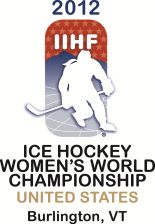BURLINGTON – Slovakia is the lovable underdog at this year’s World Women’s. In fact, the team is the underdog every time it steps onto the ice. The nation has few women hockey players—and a budget to match. But one thing it does have is one of the world’s best goalies, a goalie who could even play for the United States or Canada had she been born in North America.
But she wasn’t. Tomcikova was born in Zvolen, Slovakia, and is, in truth, what separates Slovakia from demotion. She is tall, positionally strong, and quick, and last year she was named to the tournament all-star team because she almost single-handedly kept her team in the top pool to qualify for Burlington.
Tomcikova will turn 24 later this month and is in her prime, but she makes no promises about her career beyond Sochi.
“I just finished my final year at Bemidji State, and I got my degree in mass communication. I have no clue where I’ll play next year, but I want to play at least another year and try to qualify for the next Olympics. I think we have a shot for sure. After that, I don’t know.”
In the case of Slovakia, though, that’s a lofty goal given that the team lacks offense. Last year, the team scored just four goals in five games, and yesterday the dearth of scoring reared its ugly head again. Despite playing a solid first period against Sweden, Slovakia scored only once and lost, 5-1, despite another fine game from Tomcikova.
“There’s a lot of pressure on us, and we want to do well and stay in the top group,” she admitted. “There are going to be a lot of players who have to step up, and I hope I can step up my game also.”
Slovakia has many players here in Burlington who were either on their U18 team earlier this year or who have no national team experience at all at the top level. Is this good (new talent coming in), or bad (too few players to choose from)?
“It goes both ways,” Tomcikova suggested. “It’s good for them to get experience at this level, but I think it’s going to be hard to adjust to the speed of these games. I think, as a country, we need to grow and get a lot of young players in the program. There are a few older players like me who may not be in the program much longer, so we need some young players who will replace us. They still have a long way to go, so hopefully they’ll see here there are a lot of good players and they can be so much better than they are right now.”
In the end, she thinks all the changes take the team back to square one, in some respects.
“We’re similar to last year,” Tomcikova explained. “I mean, we have some strengths, but we don’t have any players who are individually unbelievable. I think our strength is if we play well as a team and work hard. Then we can get a good result. Hard work and dedication are going to be the difference. If we’re not scared of our opponents, then we’ll be fine.”
While many of the top teams have praised the new tournament format, the goalie offers a perspective from below which is not as flattering.
“For us, I don’t think the new format is that great,” she admitted. “I understand why they did it, but for us, we’re in the bottom four, and two of those teams go to the relegation. In the other format, only one team from each group went, so there’s a 50 per cent chance we’ll be there instead of 25 per cent chance. And the four teams from the other group are safe and have no chance to be relegated. I think that’s not very good. But definitely it’s better that Canada and the U.S. and Finland will get better games.”
Although she grew up in Slovakia, Tomcikova’s development is very much a North American affair.
“I played in Caronport, Saskatchewan for two years when I was 16, along with Iveta Karafiatova and Martina Velikova. It’s a small town, but the three of us went. Iveta and I stayed for two years and Martina stayed only for one. I learned English when I was there. I then played at home for a year, then Sweden for a year, and then I came to the U.S. I’ve been around.”
Her trip to Bemidji was one very much of self-promotion. “I was sending out a lot of e-mails, but there was an NHL scout, Frank Kollar, who knew a lot of coaches and asked if they were interested in a goalie. He’s Slovakian and had seen me play. He put in a good word for me. Bemidji said yes, and I think that’s the best thing that happened to me in hockey.”
Without question, if the Europeans are to catch up with the North Americans, there has to be more training of the former in the latter. NCAA has attracted more and more girls to various programs, in part because of aggressive interest on the players’ part, in part because NCAA coaches are more open to recruitment outside North America.
“It’s definitely helping the European teams step up a level to have so many goalies in NCAA because if you have good goaltending, anything is possible. For me, I wanted to get a university education and play hockey at a high level, and NCAA is the best for that combination, I think,” Tomcikova explained.
In the end, you can’t sugar coat the situation on Team Slovakia. Without Zuzana Tomcikova, the team isn’t going to do well.
“It’s a little stressful, but over the years I’ve gotten used to it,” she said with a warm smile. “There’s always different kind of pressure for the goalie anyway, so I’ve gotten used to that.”
ANDREW PODNIEKS |
 |
 |







